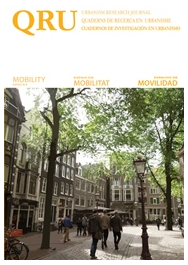Escenarios peatonales: del espacio compartido a la red exclusiva
DOI:
https://doi.org/10.5821/qru.9605Abstract
Over time, pedestrian spaces have been conceived to perform diverse roles such as settlers of an urban space, as defined –but not preferred– spaces in a diversified street section, as segregated spaces of urban life, and recently, as elements that ensure the liveliness in an area, neighborhood or city. In the majority of the mentioned roles, the pedestrian is the one who has been adapting to the resulting spaces, the ones that have come from interventions that centralize the vehicle. Currently, spaces that prioritize the pedestrian have been multiplied in the cities with the aim of bringing people to the urban structure. However, in a very imbalanced mobility system, it is absolutely necessary to plan exclusive and continuous pedestrian areas, in a connected organized network, as a mean for giving back to the pedestrian what the vehicle has taken away.Downloads
Issue
Section
License
Those authors who have publications with this journal, accept the following terms:
a. Authors will retain their copyright and guarantee the journal the right of first publication of their work, which will be simultaneously subject to the Creative Commons CC BY-NC-ND-4.0 recognition license that allows third parties to share the work provided that its author and its first publication are indicated in this journal, but they cannot be changed or used commercially.
b. Authors may adopt other non-exclusive license agreements for the distribution of the version of the published work (eg: deposit it in an institutional telematic archive or publish it in a monographic volume) provided that the initial publication in this journal is indicated.
c. Authors are allowed and recommended to disseminate their work through the Internet (e.g. in institutional telematic files or on their website) before and during the submission process, which can lead to interesting exchanges and increase citations. of the published work. (See The effect of open access).













